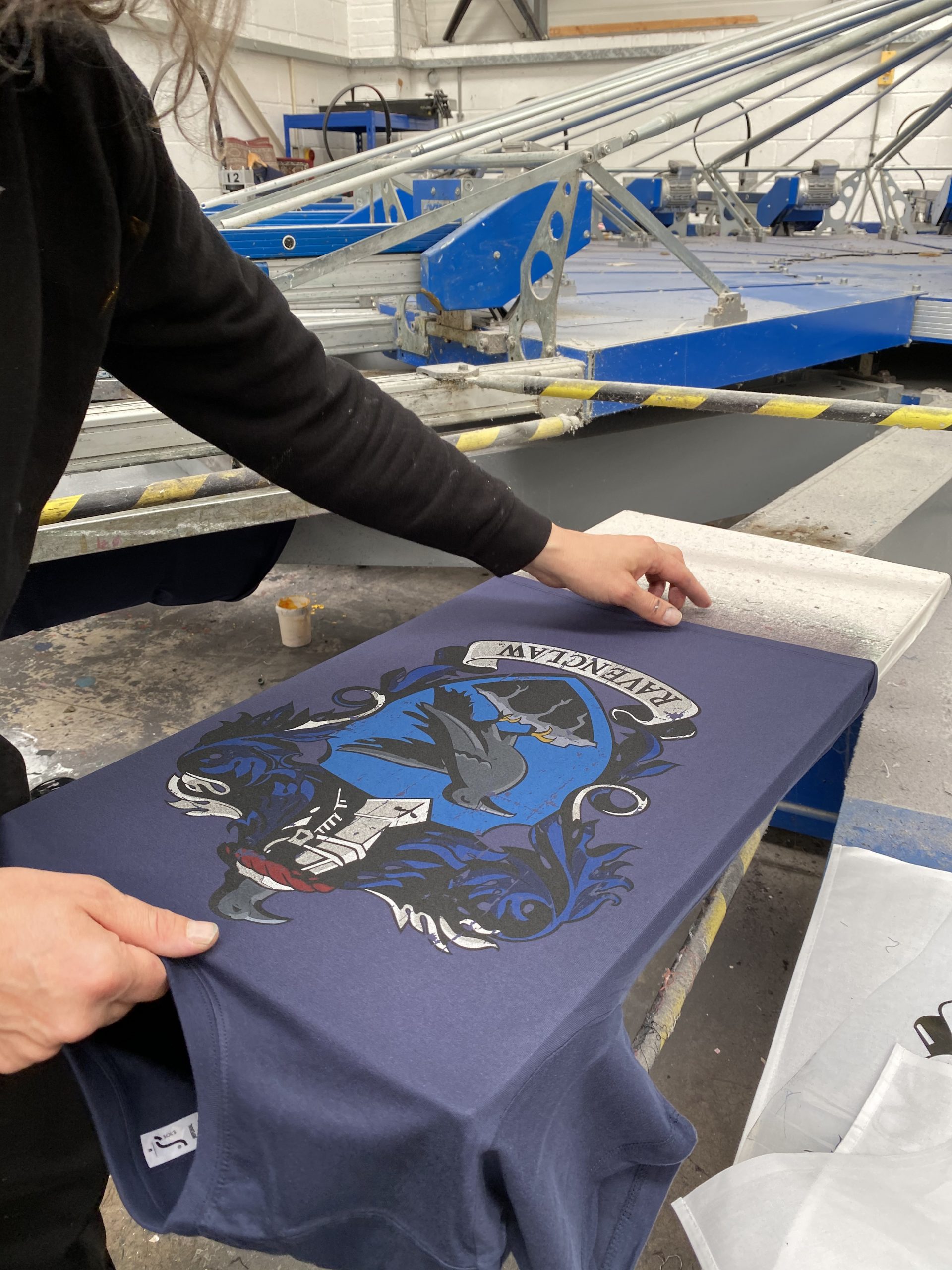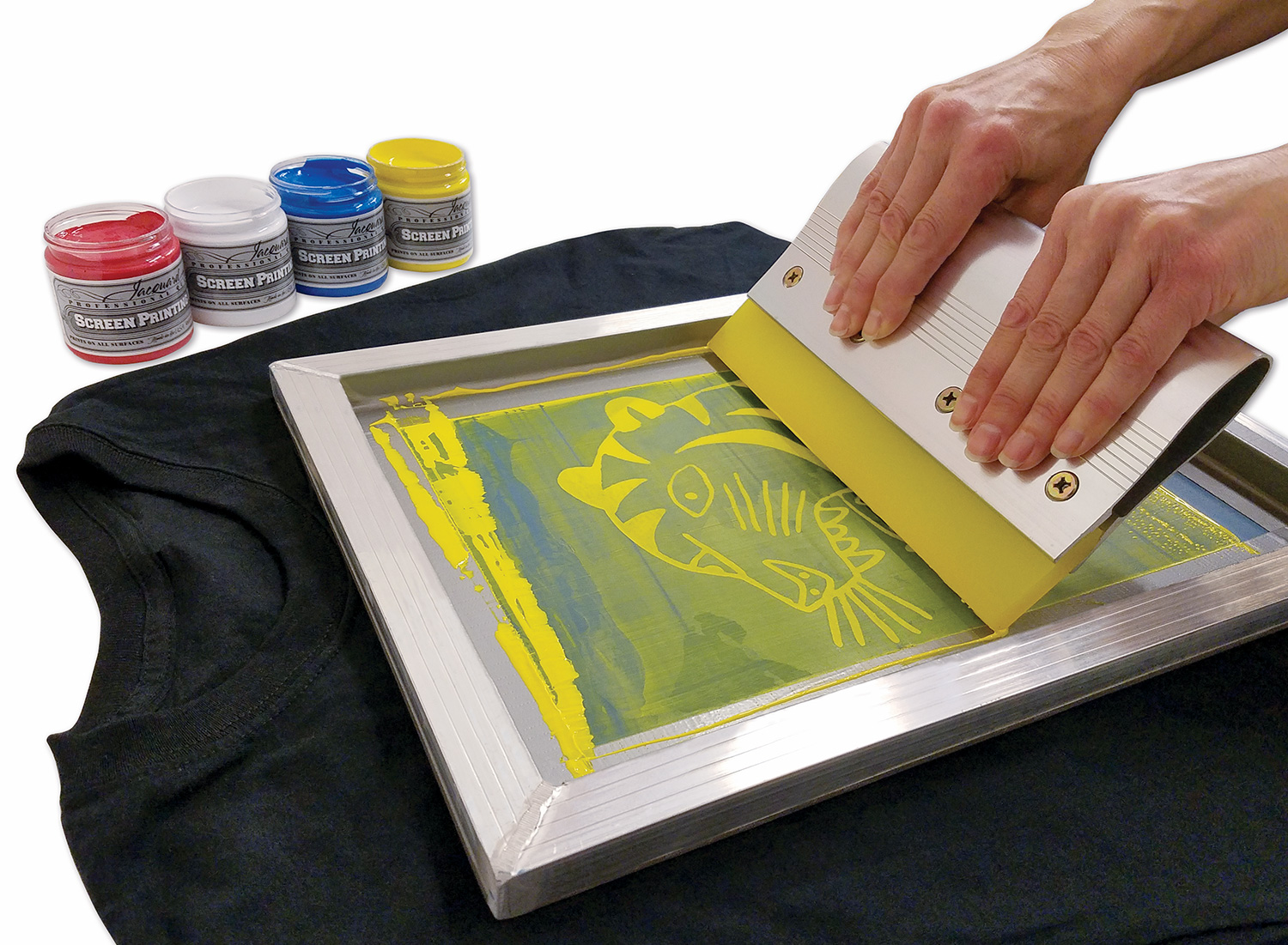Screen Printing curing and finishing techniques to guarantee vibrant results
From Style to Delivery: Grasping the Art of T-Shirt Screen Printing
The trip from style to distribution in t-shirt screen printing includes a series of critical stages that demand attention to information and tactical planning. It begins with understanding the subtleties of your target audience, adhered to by the option of ideal materials and the preparation of artwork that fulfills high criteria. As the process unravels, obstacles in top quality control and logistics can emerge, possibly affecting the last end result. Discovering these complexities discloses not just the intricacies of screen printing but additionally the vital techniques that can elevate a brand's standing in an open market.
Comprehending T-Shirt Screen Printing
Comprehending T-Shirt screen printing includes identifying a versatile and commonly made use of approach for moving designs onto material. This technique utilizes a pattern and a mesh screen to use ink onto numerous fabric materials, mainly cotton and polyester blends. The procedure begins with the development of a display that includes the preferred design, which is then carefully lined up on the fabric.
Ink is pushed through the screen's open areas making use of a squeegee, permitting exact application of shade. This method is favored for its capability to generate lively, lasting prints that hold up well to cleaning and use. Furthermore, screen printing can fitting both complex and straightforward layouts, making it a favored option for personalized apparel, marketing items, and even imaginative works.
Moreover, screen printing provides scalability, making it appropriate for both little set orders and large-scale productions. While preliminary setup expenses might be greater contrasted to various other printing approaches, the performance and longevity of screen printing usually validate the investment. On the whole, understanding the principles of T-shirt screen printing is crucial for any individual wanting to participate in this preferred form of material design, whether for personal tasks or industrial undertakings.
Conceiving Your Design
Conceiving your style is a vital action in the Tees screen printing procedure, as it sets the foundation for the entire job (Screen Printing). This stage includes generating concepts that resonate with your target market while making sure that the layout straightens with the brand name's identification and message. It is crucial to begin by checking out styles, color schemes, and graphics that show the designated visual
Mapping out preliminary ideas can be valuable, enabling a graph of concepts before completing the style. Take into consideration the usage of typography, images, and design in a manner that records attention and communicates properly. In addition, it is important to expect the printing strategy that will certainly be employed, as this can affect style intricacy and color choices.
Taking part in conceptualizing sessions with staff member or looking for responses from potential clients can additionally improve the concept procedure, providing varied perspectives that fine-tune the style. Eventually, a well-balanced style not only boosts the aesthetic allure of the Tees however likewise promotes a link with the audience, driving passion and prospective sales. For that reason, committing time to conceive your design can result in a successful screen printing result.
Selecting the Right Materials

The weight of the fabric, commonly gauged in grams per square meter (GSM), influences the drape and total feel of the T-shirt. Much heavier textiles may offer a much more premium look, while lighter choices fit for sportswear. Appearance also contributes; smoother fabrics tend to produce sharper prints, while textured surfaces can produce one-of-a-kind aesthetic impacts.
Furthermore, consider the ecological influence of materials. Organic cotton and recycled polyester are acquiring appeal amongst eco-conscious customers. Ultimately, picking the ideal materials includes stabilizing visual charm, performance, and sustainability, guaranteeing that the T-shirt not just looks wonderful but additionally meets the assumptions of your target audience.
Preparing Art Work for Printing
Preparing artwork for T-shirt screen printing needs mindful Abilene T-Shirt Screen Printing Company attention to information to assure that the final print properly mirrors the desired layout. The very first step is to create a high-resolution electronic data, ideally in vector style, as this permits scalability without loss of high quality. Common software application made use of for this objective consists of Adobe Illustrator and CorelDRAW.
Next off, validate that all text is transformed to details or rasterized to prevent font problems throughout printing (Abilene T-Shirt Screen Printing Company). Additionally, it is important to validate that the shade setting is readied to CMYK, as this straightens with the printing procedure. Pay close interest to shade matching; utilizing Pantone colors can aid achieve consistency across different prints
Think about the dimensions of the print location and preserve appropriate margins to stay clear of design cutoff. It's likewise important to include enrollment marks for placement throughout the printing process. Screen Printing. Finally, demand a proof from the printer to imagine the final item prior to mass production. This step is important for recognizing any potential issues, ensuring that the published T-shirt meets the wanted top quality and design requirements. Appropriate prep work of artwork significantly affects the overall success of the screen printing task
Mastering the Printing Process
Grasping the printing process is important for accomplishing high-quality results in Tee shirts screen printing. This stage entails numerous considerable steps that directly affect the final product. The very first step is establishing the printing machine properly. Appropriate enrollment of screens guarantees that shades line up appropriately, preventing misprints and guaranteeing an expert look.
Next, choosing the right ink is essential. Different ink types, such as plastisol or water-based, offer various coatings and resilience. Comprehending the fabric structure of the T-shirt also assists in selecting suitable inks.
When it involves the actual printing, controlling the squeegee pressure and angle is vital. Constant pressure will produce even ink circulation, while the angle affects the flow and protection. Additionally, adjusting the speed of the printing machine can influence the ink's curing process, which is fundamental for guaranteeing toughness.
Top Quality Control and Finishing
After the printing process is total, implementing effective high quality control procedures ends up being vital to confirm that each Tees meets the wanted standards. Quality control entails a systematic technique to inspecting each garment for flaws, confirming that the print quality, shade precision, and fabric stability straighten with the specifications set during the layout stage.

The very first step in quality assurance is an extensive aesthetic examination. This requires monitoring for usual concerns such as imbalance, ink spots, or fading. Any type of Tee shirts that does not fulfill the top quality standards need to be resolved promptly, either via reprinting or fixing.
Along with aesthetic checks, it is very important to perform clean examinations on an example of printed t-shirts to evaluate the toughness of the inks and the total long life of the style. These tests assist validate that the print will certainly keep its vibrancy and integrity after multiple laundries, an important aspect for client complete satisfaction.
Ending up touches, such as thread trimming and the application of treatment tags, additionally play a substantial function in quality assurance - Business Branding Services. By concentrating on these elements, companies can enhance the total discussion of their products, inevitably bring about a much more rewarding consumer experience
Product Packaging and Delivery Solutions

To accomplish excellent packaging, consider utilizing environmentally friendly products that straighten with sustainability fads, such as recyclable poly bags or eco-friendly boxes. Each T-shirt should be neatly folded and placed in protective wrapping to avoid creasing and prospective damages during transit. Including a top quality insert or care directions can even more customize the experience, promoting customer loyalty.
Picking a trusted delivery partner is vital when it comes to shipment. Evaluate alternatives based upon price, monitoring, and rate capacities. Supplying numerous shipping methods can accommodate various client needs, from basic to expedited shipping.
Regularly Asked Concerns
What Are the Common Blunders Novices Make in Screen Printing?
Common blunders novices make in screen printing consist of incorrect screen preparation, poor ink mixing, incorrect direct exposure times, insufficient healing, and ignoring to test prints. These mistakes can result in low quality and disappointing outcomes in end products.
How Can I Stop Ink From Bleeding During Printing?
To prevent ink blood loss during printing, assurance proper screen tension, usage suitable solution thickness, choose the right ink consistency, keep optimal healing temperatures, and prevent overloading the screen with extreme ink throughout application.
What Sorts of Inks Are Finest for Various Fabrics?
Selecting inks based on textile type is necessary. Water-based inks are ideal for cotton, supplying softness. Plastisol inks suit artificial fabrics, providing durability. Discharge inks successfully mix with natural fibers, making certain lively colors without endangering fabric stability.
Exactly how Do I Pick the Right Screen Mesh Matter?
Choosing the best screen mesh matter relies on the wanted print information and ink type. Abilene T-Shirt Screen Printing Company. Higher mesh counts generate better details, while lower matters facilitate thicker inks. Examine textile type and design complexity for excellent results
Can I Utilize Screen Printing for Tiny Set Orders?
Yes, screen printing can be effectively used for tiny set orders. This approach allows for comprehensive styles and high-grade results, making it a feasible alternative for custom apparel, marketing products, or restricted version runs.
Recognizing T-Shirt screen printing entails recognizing a flexible and commonly utilized approach for moving designs onto fabric. While first configuration prices might be greater contrasted to various other printing techniques, the performance and durability of screen printing frequently justify the investment. Preparing artwork for T-shirt screen printing calls for mindful focus to information to ensure that the final print accurately reflects the desired layout. Understanding the printing procedure is vital for accomplishing premium results in T-shirt screen printing. Usual blunders novices make in screen printing include improper screen prep work, poor ink blending, inaccurate exposure times, insufficient curing, and disregarding to evaluate prints.